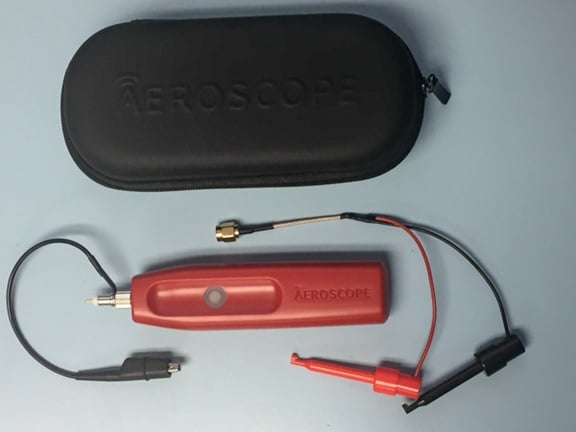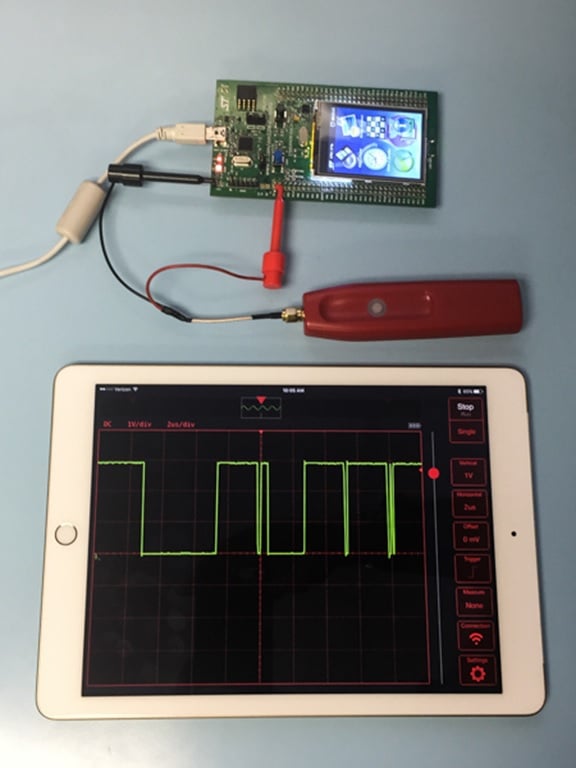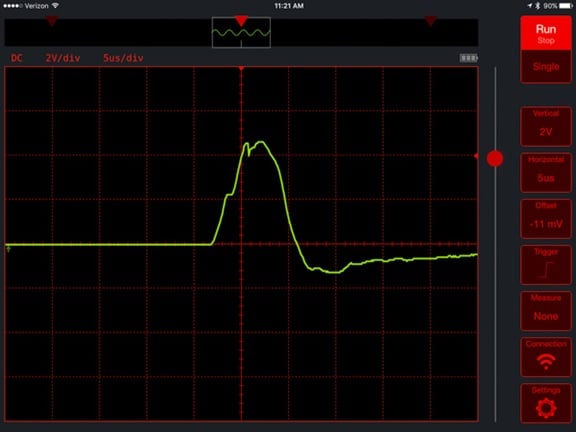In photography, they say the best camera is the one you have with you. The same may be said for simple electronic test equipment. For example, I was recently working with a client and we needed to verify Vcc voltage on one of their boards. Not having a DMM quickly available in their lab, I pulled out a tiny DMM from my troubleshooting kit, no larger than a pack of cigarettes. While the clients were surprised somewhat, it got the job done.
In a similar vein, oscilloscopes have been shrinking with newly integrated acquisition technology, and one company based in Colorado has just released the Aeroscope wireless oscilloscope through Crowd Supply, an oscilloscope about the size of the old digital logic probes we used to use 20 years ago (Figure 1). The first batch is sold out, but the second batch may be preordered for $199.
The Aeroscope is a 20 MHz bandwidth, 100 MSa/s, 8-bit single channel oscilloscope that may be wirelessly connected to Apple iOS devices via Bluetooth. The rechargeable battery can supply energy for a full day of measurements and the wireless range is up to 30m. An app for Android platforms is on the “to-do” list. The waveforms are captured and stored at 100 MSa/s and full screens of captured data are streamed continuously to your phone or tablet.
Here’s the full set of technical specifications from their website.
- Sample Rate: 100 MSPS
- Analog Bandwidth: 20 MHz
- Input Impedance: 1 Mohm || 17 pF
- Voltage Resolution: 100 mV/div – 10 V/div
- Measurable Input Voltage Range: +/- 40 V
- Channels: 1
- Sample Resolution: 8 bits
- Memory Depth: 4k samples
- Wireless Protocol: Bluetooth LE (Bluetooth 4.0)
- Wireless Range: 100+ ft / 30+ m
- Compatible with iPad and iPhone
- Add new features just by updating the app
- Touch gesture support for quick setting changes
- Built in waveform measurements and cursors
- Battery Size: 950 mAh
- Battery Life: All day use (typical: 8+ hours)
- Standard package includes probe tip, mini-grabbers, standard ground lead, and case
- MSRP: $199
The data sheet may be downloaded here.

Being wireless, the unit is fully isolated from earth ground and may be wired into mobile devices or platforms, such as robots, autonomous vehicles, and the like. As such, the oscilloscope ground reference may be connected anywhere without worrying about damage to your circuit. For example, it could be used to easily measure switch mode power supply nodes. Figure 2 shows the whole system measuring a bus signal on a processor board and wirelessly streaming to my iPad.
While the basic voltage measurement limit is just +/- 40 V, the SMA connector may be adapted to standard 10:1 passive oscilloscope probes via an SMA to BNC adapter to enable up to +/- 400 V measurements.

The open source app is still under development, but offers basic vertical measurements of 100 mV to 10 V per division and time base of 50 ns to 5 s per division. Triggering includes rising/falling edge, any edge, glitch capture, and auto/normal modes. Some secondary features will be added as development proceeds. Automated measurement modes with the current release include peak-to-peak, maximum, minimum, and average voltages. Additional automated measurements will eventually include overshoot, undershoot, frequency, period, duty cycle, and rise/fall times.
Here are the technical specifications of the software:
- Compatible with iOS 9 devices that support Bluetooth 4.0 (iPhone 4S and later, iPad 3 and later, iPod touch 5th generation and later, iPad mini, and iPad pro)
- Touch Gesture support for offset, trigger delay, horizontal, and vertical scales
- Trigger Control (Rising Edge, Falling Edge, Any Edge, Glitch Filter)
- Measurements – amplitude available upon ship (Vpp, Vmax, Vmin, Vavg), time based measurements coming soon via an app update (frequency, period, duty cycle)
- Open Source
Just for fun, I attempted to capture an ESD waveform with the expected results of very limited bandwidth (Figure 3). I used a nearby BBQ lighter and coupled it loosely into the pigtail input leads. While not displaying the true edge speeds, it does show the amplitude pretty well and will be useful in demonstrating how various devices can generate ESD.

While not the most powerful oscilloscope, the size is perfect for including in my EMC troubleshooting kit and measuring, or at least verifying, key signals in products I’m evaluating. Connection to both my older (Gen 3) and newest (Gen 5) iPads was a seamless, two-step, process. The build quality is superb and I appreciate the standard SMA connector for the input, allowing me to attach standard passive 10:1 scope probes. The button on the side is used to start and stop the acquisition and battery life is exceptional. What’s not to like in a basic economy oscilloscope? Recommended.
References:




